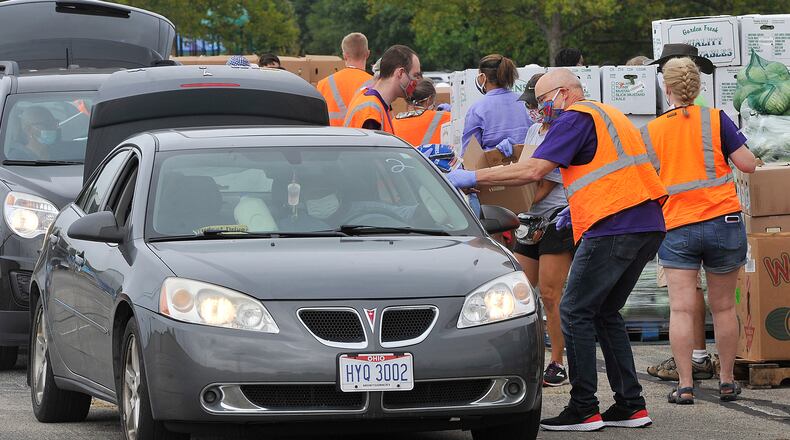The Foodbank served over 3,300 people, or about 1,100 households, on Thursday, according to Chief Development Officer Lee Lauren Truesdale. About 700 of those households were first-time emergency food users.
People waiting in the long line told stories of how the pandemic has disrupted their livelihoods in a variety of ways, causing them to seek food assistance for the first time or more frequently than before the pandemic.
“I haven’t been able to work for a while now, I haven’t been able to provide everything I used to be able to provide for my family,” said Tasha Smyth.
Smyth supports her five kids and her mother. Thursday was her first time coming to the Foodbank for assistance. Before the pandemic, Smyth worked as a home healthcare provider. Since May, she has not been able to work in part because of a lack of childcare options.
Smyth said it has been especially difficult to make ends meet since the end of July when the $600 federal unemployment boost she was receiving went away. She hopes Congress provides additional financial relief soon.
Credit: Marshall Gorby
Credit: Marshall Gorby
Chris and Stefanie Hoffman, making their way through the line with their two kids in the back seat, said dealing with the unemployment system over the last five months has been a “nightmare.” Chris Hoffman was not working when Stefanie Hoffman was laid off from her job as an imaging operator in March. After numerous phone calls, the couple was only able to get unemployment benefits for Stefanie in June. She collected the extra $600 benefit for only a few weeks, during which they lost their food stamps due to receiving the extra income. Now that they aren’t getting the additional $600, the family is trying to get their food stamps back.
Chris Hoffman said the only jobs they could find right now wouldn’t provide enough hours or income.
“The only offers we got are like 18-20 hours a week, nothing a family could live on,” he said.
Besides, with their kids attending school online, one of them has to stay home.
Related: Jobless claims inch down again, but layoffs continue
Steven Burge agreed the process of applying for unemployment is really slow. Other than the $1,200 federal stimulus check, he hasn’t received any other assistance yet.
“I was working before and now I’ve very seldom been working,” he said. “I do home repair and people don’t want you in their homes because of COVID … (This food) will help feed my kids. Me, I’m not too much worried about myself. I’m worried about them more than ever.”
Demand has leveled off since the need for food soared in March and the first part of April, said Truesdale, but the Foodbank and its partner agencies continue to see increased need compared to normal.
The Foodbank held three mass distributions last summer that were also well-attended due to the tornado outbreak. To meet the increased need for food in the Dayton area this summer, the Foodbank has held five distributions across Preble, Montgomery and Greene counties, with one more planned.
The Foodbank has also increased the number of days per week its drive-thru operates from two to three. On average in August, the drive-thru has served over 200 families each day it’s open. On average, 50 of those families were new to the Foodbank.
About the Author



